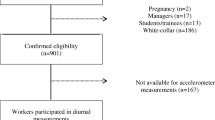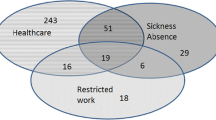Abstract
Purpose
To investigate if occupational physical activity (OPA) and leisure-time physical activity (LTPA) influence the association between musculoskeletal pain and sleep problems.
Methods
Cross-sectional study includes 678 workers in the Danish PHysical ACTivity cohort with Objective measurements (DPhacto). Musculoskeletal pain was assessed by questionnaires, while OPA and LTPA were measured with accelerometers for up to 6 consecutive days. We used logistic regression to calculate odds ratios (ORs) with 95% confidence intervals (CIs) for self-reported insomnia symptoms and non-restorative sleep.
Results
Analyses of the joint association of musculoskeletal pain and OPA showed that workers with high pain and high OPA had ORs of 5.80 (95% CI 2.64–12.67) for insomnia symptoms and 2.50 (95% CI 1.37–4.57) for non-restorative sleep, compared to those with low pain and low OPA, whereas workers with high pain and low OPA had ORs of 4.67 (95% CI 2.17–10.07) for insomnia symptoms, and 2.67 (95% CI 1.46–4.89) for non-restorative sleep, respectively. Furthermore, workers with high pain and high LTPA had ORs of 4.23 (95% CI 2.16–8.32) for insomnia symptoms and 1.95 (95% CI 1.09–3.48) for non-restorative sleep, compared to those with low pain and low LTPA, whereas workers with high pain and low LTPA had ORs of 3.34 (95% CI 1.66–6.70) for insomnia symptoms and 2.14 (95% CI 1.21–3.80) for non-restorative sleep, respectively.
Conclusions
Workers with high musculoskeletal pain who also conducted high levels of OPA or LTPA reported higher prevalence of insomnia symptoms.
Similar content being viewed by others
References
Åkerstedt T, Fredlund P, Gillberg M, Jansson B (2002) Work load and work hours in relation to disturbed sleep and fatigue in a large representative sample. J Psychosom Res 53:585–588. https://doi.org/10.1016/S0022-3999(02)00447-6
American Psychiatric Association (2013) Diagnostic and statistical manual of mental disorders, 5th edn. American Psychiatric Publishing, Washington
Andersson T, Alfredsson L, Kallberg H, Zdravkovic S, Ahlbom A (2005) Calculating measures of biological interaction. Eur J Epidemiol 20:575–579
Andrews NE, Strong J, Meredith PJ, D’Arrigo RG (2014) Association between physical activity and sleep in adults with chronic pain: a momentary, within-person perspective. Phys Ther 94:499–510. https://doi.org/10.2522/ptj.20130302
Anothaisintawee T, Reutrakul S, Van Cauter E, Thakkinstian A (2015) Sleep disturbances compared to traditional risk factors for diabetes development: systematic review and meta-analysis. Sleep Med Rev 30:11–24. https://doi.org/10.1016/j.smrv.2015.10.002
Axen I, Kwak L, Hagberg J, Jensen I (2017) Does physical activity buffer insomnia due to back and neck pain? PLoS One 12:e0184288. https://doi.org/10.1371/journal.pone.0184288
Chennaoui M, Arnal PJ, Sauvet F, Leger D (2015) Sleep and exercise: a reciprocal issue? Sleep Med Rev 20:59–72. https://doi.org/10.1016/j.smrv.2014.06.008
Dew M, Hoch CC, Buysse DJ, Monk TH, Begley AE, Houck PR, Hall M, Kupfer DJ, Reynolds CF (2003) Healthy older adults’ sleep predicts all-cause mortality at 4 to 19 years of follow-up. Psychosom Med 65:63–73
Flausino NH, Da Silva Prado JM, de Queiroz SS, Tufik S, de Mello MT (2012) Physical exercise performed before bedtime improves the sleep pattern of healthy young, good sleepers. Psychophysiology 49:186–192
Geisser ME, Robinson ME, Richardson C (1995) A time series analysis of the relationship between ambulatory EMG, pain, and stress in chronic low back pain. Biofeedback Self Regul 20:339–355
Geneen LJ, Moore RA, Clarke C, Martin D, Colvin LA, Smith BH (2017) Physical activity and exercise for chronic pain in adults: an overview of Cochrane reviews. Cochrane Database Syst Rev. https://doi.org/10.1002/14651858.CD011279.pub2
Gupta N, Heiden M, Mathiassen SE, Holtermann A (2016) Prediction of objectively measured physical activity and sedentariness among blue-collar workers using survey questionnaires. Scand J Work Environ Health 42:237–245. https://doi.org/10.5271/sjweh.3561
Gupta N, Heiden M, Mathiassen SE, Holtermann A (2017) Is self-reported time spent sedentary and in physical activity differentially biased by age, gender, body mass index, and low-back pain? Scand J Work Environ Health. https://doi.org/10.5271/sjweh.3693
Holtermann A, Burr H, Hansen JV, Krause N, Sogaard K, Mortensen OS (2012) Occupational physical activity and mortality among Danish workers. Int Arch Occup Environ Health 85:305–310. https://doi.org/10.1007/s00420-011-0668-x
Jørgensen MB, Korshøj M, Lagersted-Olsen J, Villumsen M, Mortensen OS, Skotte J, Søgaard K, Madeleine P, Thomsen BL, Holtermann A (2013) Physical activities at work and risk of musculoskeletal pain and its consequences: protocol for a study with objective field measures among blue-collar workers. BMC Musculoskelet Disord 14:213. https://doi.org/10.1186/1471-2474-14-213
Kessler RC, Berglund PA, Coulouvrat C, Hajak G, Roth T, Shahly V, Shillington AC, Stephenson JJ, Walsh JK (2011) Insomnia and the performance of US Workers: results from the America Insomnia Survey. Sleep 34:1161–1171. https://doi.org/10.5665/sleep.1230
King AC, Pruitt LA, Woo S, Castro CM, Ahn DK, Vitiello MV, Woodward SH, Bliwise DL (2008) Effects of moderate-intensity exercise on polysomnographic and subjective sleep quality in older adults with mild to moderate sleep complaints. J Gerontol A Biol Sci Med Sci 63:997–1004
Koch M, Lunde LK, Gjulem T, Knardahl S, Veiersted KB (2016) Validity of questionnaire and representativeness of objective methods for measurements of mechanical exposures in construction and health care work. PLoS One. https://doi.org/10.1371/journal.pone.0162881
Kubitz KA, Landers DM, Petruzzello SJ, Han M (1996) The effects of acute and chronic exercise on sleep. A meta-analytic review. Sports Med 21:277–291
Lallukka T, Kaikkonen R, Härkänen T, Kronholm E, Partonen T, Rahkonen O, Koskinen S (2014) Sleep and sickness absence: a nationally representative register-based follow-up study. Sleep 37:1413–1425. https://doi.org/10.5665/sleep.3986
Loprinzi PD, Cardinal BJ (2011) Association between objectively-measured physical activity and sleep, NHANES 2005–2006. Ment Health Phys 4:65–69
Miglis MG (2016) Autonomic dysfunction in primary sleep disorders. Sleep Med 19:40–49. https://doi.org/10.1016/j.sleep.2015.10.001
Ødegard SS, Sand T, Engstrøm M, Zwart JA, Hagen K (2013) The impact of headache and chronic musculoskeletal complaints on the risk of insomnia: longitudinal data from the Nord-Trondelag health study. J Headache Pain 14:24. https://doi.org/10.1186/1129-2377-14-24
Roth T, Zammit G, Lankford A, Mayleben D, Stern T, Pitman V, Clark D, Werth JL (2010) Nonrestorative sleep as a distinct component of insomnia. Sleep 33:449–458
Sayar K, Arikan M, Yontem T (2002) Sleep quality in chronic pain patients. Can J Psychiatry 47:844–848. https://doi.org/10.1177/070674370204700905
Sivertsen B, Krokstad S, Øverland S, Mykletun A (2009) The epidemiology of insomnia: associations with physical and mental health. The HUNT-2 study. J Psychosom Res 67:109–116. https://doi.org/10.1016/j.jpsychores.2009.05.001
Skarpsno ES, Nilsen TIL, Sand T, Hagen K, Mork PJ (2018a) Do physical activity and body mass index modify the association between chronic musculoskeletal pain and insomnia? Longitudinal data from the HUNT study, Norway. J Sleep Res 27:32–39. https://doi.org/10.1111/jsr.12580
Skarpsno ES, Mork PJ, Nilsen TIL, Jorgensen MB, Holtermann A (2018b) Objectively measured occupational and leisure-time physical activity: cross-sectional associations with sleep problems. Scand J Work Environ Health. https://doi.org/10.5271/sjweh.3688
Skotte J, Korshøj M, Kristiansen J, Hanisch C, Holtermann A (2014) Detection of physical activity types using triaxial accelerometers. J Phys Act Health 11:76–84. https://doi.org/10.1123/jpah.2011-0347 doi
Sluiter JK, Frings-Dresen MH, Meijman TF, van der Beek AJ (2000) Reactivity and recovery from different types of work measured by catecholamines and cortisol: a systematic literature overview. Occup Environ Med 57:298–315
Soltani M, Haytabakhsh MR, Najman JM, Williams GM, O’Callaghan MJ, Bor W, Dingle K, Clavarino A (2012) Sleepless nights: the effect of socioeconomic status, physical activity, and lifestyle factors on sleep quality in a large cohort of Australian women. Arch Womens Ment Health 15:237–247
Tang NK, McBeth J, Jordan KP, Blagojevic-Bucknall M, Croft P, Wilkie R (2015) Impact of musculoskeletal pain on insomnia onset: a prospective cohort study. Rheumatology 54:248–256. https://doi.org/10.1093/rheumatology/keu283
Uehli K, Mehta AJ, Miedinger D, Hug K, Schindler C, Holsboer-Trachsler E, Leuppi JD, Künzli N (2014) Sleep problems and work injuries: a systematic review and meta-analysis. Sleep Med Rev 18:61–73. https://doi.org/10.1016/j.smrv.2013.01.004
Vgontzas A, Liao D, Bixler E, Chrousos G, Vela-Bueno A (2009) Insomnia with objective short sleep duration is associated with a high risk for hypertension. Sleep 32:491–497
Virtanen M, Ferrie JE, Gimeno D, Vahtera J, Elovainio M, Singh-Manoux A, Marmot MG, Kivimäki M (2009) Long working hours and sleep disturbances: the Whitehall II prospective cohort study. Sleep 32:737–745
Wennman H, Kronholm E, Partonen T, Tolvanen A, Peltonen M, Vasankari T, Borodulin K (2014) Physical activity and sleep profiles in Finnish men and women. BMC Public Health 14:82–91. https://doi.org/10.1186/1471-2458-14-82
Yong LC, Li J, Calvert GM (2017) Sleep-related problems in the US working population: prevalence and association with shiftwork status. Occup Environ Med 74:93–104. https://doi.org/10.1136/oemed-2016-103638
Acknowledgements
The authors would like to thank the DPhacto research group and personnel who contributed to the data collection and analysis, especially Julie Lagersted-Olsen, Dorte Ekner, Klaus Hansen, and Jørgen Skotte.
Funding
This work was supported by a grant to Eivind Schjelderup Skarpsno from the Liaison Committee between the Central Norway Regional Health Authority (RHA) and the Norwegian University of Science and Technology (NTNU). The National Research Centre for the Working Environment (NRCWE), and the Danish Working Environment Research Fund (Reference Number 11-2017-03) financed the data collection of this study.
Author information
Authors and Affiliations
Contributions
Study concept and design: all authors. Drafting of the manuscript: ESS. Critical revision of the manuscript: all authors. Statistical analysis: ESS, PJM, TILN, and AH. Analysis and interpretation of data: all authors. Critical revision: all authors. Final approval: all authors.
Corresponding author
Ethics declarations
Conflict of interest
The authors declare no conflicts of interest.
Ethical approval
The study was approved by the Ethics Committee for the Capital Region of Denmark and conducted in accordance with the Declaration of Helsinki.
Informed consent
All workers who participated in the study signed an informed consent.
Rights and permissions
About this article
Cite this article
Skarpsno, E.S., Mork, P.J., Nilsen, T.I.L. et al. The joint association of musculoskeletal pain and domains of physical activity with sleep problems: cross-sectional data from the DPhacto study, Denmark. Int Arch Occup Environ Health 92, 491–499 (2019). https://doi.org/10.1007/s00420-018-1382-8
Received:
Accepted:
Published:
Issue Date:
DOI: https://doi.org/10.1007/s00420-018-1382-8




